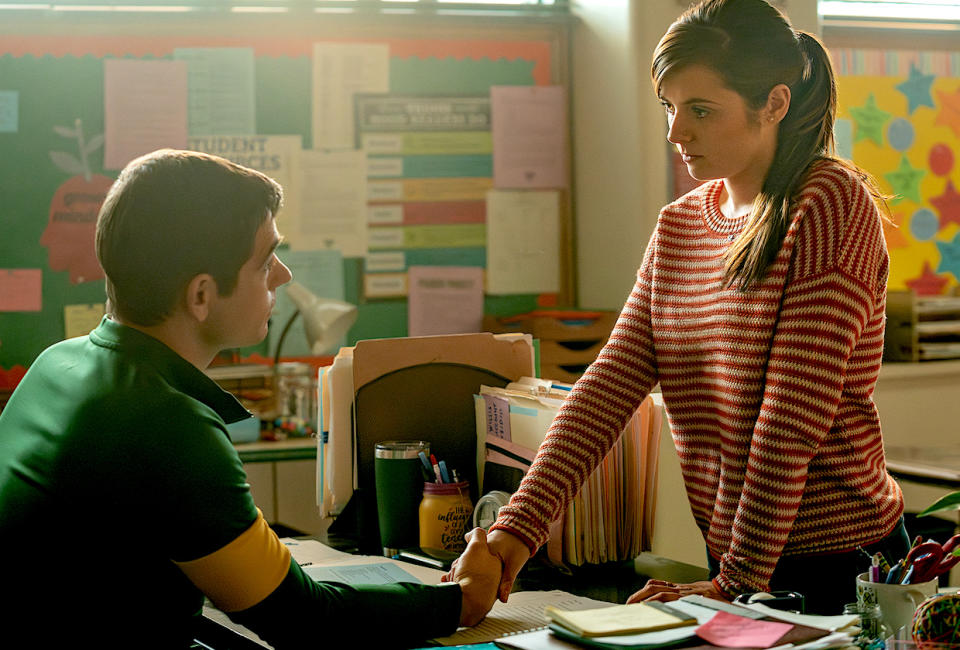Three Women: How the Starz Adaptation Achieves the Rare Feat of Being Even Better Than the Book
The age-old question when it comes to any TV adaptation: Will it live up to the book? Starz’s Three Women answers with a resounding, “No — it’s even better!”
The limited series, which premieres this Friday at 10/9c, is based on Lisa Taddeo’s bestselling nonfiction book and stars Shailene Woodley (Big Little Lies) as Gia, a writer grieving the loss of her family. “Struggling to discover a topic she feels passionate enough to write about, Gia takes a trip across the country,” per the official description, and “crosses paths with three women, each unheard and misunderstood, and feels pulled to share their true stories and desires in a space free of judgment.”
More from TVLine
Three Women Premiere Flirts With Female Desire in America - Grade the Episode!
Power Book II: Ghost Midseason Premiere Recap: Carter Crosses a Line
The women Gia meets are Lina (played by GLOW’s Betty Gilpin), an Indiana homemaker stuck in a loveless marriage who “embarks on an affair that quickly becomes all-consuming and transforms her life”; Sloane (She’s Gotta Have It’s DeWanda Wise), a glamorous entrepreneur whose open marriage to Richard (Blair Underwood) seems perfect until “two sexy new strangers threaten their aspirational love story”; and Maggie (Gabrielle Creevy), a North Dakota student who “weathers an intense storm after accusing her married English teacher of an inappropriate relationship.”
But how exactly does the adaptation pull off the rare feat of being even better than a great book? Let’s dive in.
Less Depressing, More Lively!

Though the book is framed as a story about female desire, it often feels like it’s male desire dictating the course of each woman’s relationship: Lina is merely an object of her ex-boyfriend’s unreliable lust; Sloane is bending herself backwards to keep her husband satisfied in an open marriage she didn’t ask for; and Maggie is villainized by her community after accusing a beloved teacher of sexual assault. In the series, however, the women come into sharper focus, thanks in part to Wise’s flirtatious charisma as Sloane, Creevy’s intense self-assurance as Maggie, Gilpin’s soft strength as Lina, and Woodley’s clever pursuit of a good story as Gia. We see that these are truly remarkable women seeking more for themselves. They are not victims of the men who stand in their way.
The Betty Gilpin Effect

And it’s Gilpin’s standout performance in particular that helps keep the series from falling into a depressive hole. In the book, Lina can seem pathetic, like she’s girlishly seeking male approval to no end. But the series proves that Lina is, in fact, revolutionary. It’s Gilpin’s masterful understanding of her character’s interiority that allows for this transformation. The actress tells TVLine that while aspects of Lina’s story can be “sad and beige,” Gilpin “did want to make it feel like, regardless of what her circumstances were, or how it looks, [Lina’s] like, ‘at any second, it’s going to morph into my fairy princess tale.’” And Lina’s childlike wonder, the part of her that believes she “could be the Princess Buttercup in [her] own story,” as Gilpin describes it, feels monumental, rave-worthy and new to TV.
Male Nudity Like You’ve Never Seen!

As in the book, intimacy — both physical and emotional — is central to each woman’s story. And the series doesn’t shy away from on-screen sex — in fact, it completely changes the way sex is performed for the camera. “We really were shooting the show from the female gaze,” executive producer/showrunner Laura Eason tells TVLine. “And for these women, and these relationships, that means a certain level of objectification of the male body.” So yes, expect lots of beauty shots of… the male anatomy.
But the series doesn’t ignore the complexity of intimacy. “We really are trying to infuse all the intimacy scenes with deep truth and real feeling, and really showing what the emotional arc is of these scenes, and how different they can be — even in a single sexual experience,” Eason shares. Three Women offers women a chance to watch their own sexuality be depicted on TV as an intense and complicated experience, in a way shows like Sex and the City and Girls got close to, but could never fully achieve. But do not be fooled: According to Underwood, “It’s not just for women, by women. It’s also for men who are brave enough to just dive in and be open-minded.”
Thoughtful Changes

Finally, the book’s shortcomings have always been obvious: It claims to tell a universal story about female desire while only including the experiences of three white women. The series makes necessary changes, turning Sloane into a composite character who is Black and addresses her particular experiences as a Black woman. While there is nothing worse than an adaptation correcting its source material’s wrongs with half-baked ideas, or partially developed new characters, Three Women never feels like it’s simply checking a box to avoid further criticism. Sloane’s story feels thorough and seamlessly fits into the larger narrative.
So tell us: Are you planning to watch Three Women? Hit the comments with your thoughts!
Best of TVLine
Sign up for TVLine's Newsletter. For the latest news, follow us on Facebook, Twitter, and Instagram.
